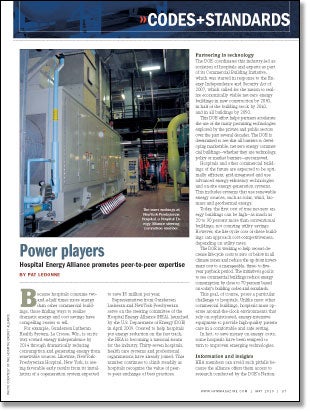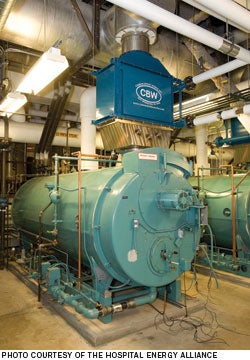Power players
 Because hospitals consume two-and-a-half times more energy than other commercial buildings, those finding ways to realize dramatic energy and cost savings have compelling stories to tell.
Because hospitals consume two-and-a-half times more energy than other commercial buildings, those finding ways to realize dramatic energy and cost savings have compelling stories to tell.
For example, Gundersen Lutheran Health System, La Crosse, Wis., is on its way toward energy independence by 2014 through dramatically reducing consumption and generating energy from renewable sources. Likewise, NewYork-Presbyterian Hospital, New York, is seeing favorable early results from its installation of a cogeneration system expected to save $5 million per year.
Representatives from Gundersen Lutheran and NewYork-Presbyterian serve on the steering committee of the Hospital Energy Alliance (HEA), launched by the U.S. Department of Energy (DOE) in April 2009. Created to help hospitals put energy reduction on the fast track, the HEA is becoming a national forum for the industry. Thirty-seven hospitals, health care systems and professional organizations have already joined. That number continues to climb steadily as hospitals recognize the value of peer-to-peer exchange of best practices.
Partnering in technology
The DOE coordinates this industry-led association of hospitals and experts as part of its Commercial Building Initiative, which was started in response to the Energy Independence and Security Act of 2007, which called for the nation to realize economically viable net-zero energy buildings in new construction by 2030,
in half of the building stock by 2040, and in all buildings by 2050.
This DOE effort helps partners accelerate the use of the many promising technologies explored by the private and public sectors over the past several decades. The DOE is determined to see that all barriers to developing marketable, net-zero energy commercial buildings—whether they are technology, policy or market barriers—are removed.
Hospitals and other commercial buildings of the future are expected to be optimally efficient, grid-integrated and use advanced energy-efficiency technologies and on-site energy-generation systems. This includes systems that use renewable energy sources, such as solar, wind, biomass and geothermal energy.
Today, the first cost of true net-zero energy buildings can be high—as much as 20 to 30 percent more than conventional buildings, not counting utility savings. However, the life-cycle cost of these buildings can approach cost-competitiveness, depending on utility rates.
The DOE is working to help sectors decrease life-cycle costs to zero or below in all climate zones and reduce the up-front investment cost to a manageable, three- to five-year payback period. The initiative's goal is to see commercial buildings reduce energy consumption by close to 70 percent based on today's building codes and standards.
This goal, of course, poses a particular challenge to hospitals. Unlike most other commercial buildings, hospitals must operate around-the-clock environments that rely on sophisticated, energy-intensive equipment to provide high-quality patient care in a comfortable and safe setting.
In fact, to save money on energy costs, some hospitals have been tempted to turn to unproven emerging technologies.
Information and insights
HEA members can avoid such pitfalls because the alliance offers them access to research conducted by the DOE's National Laboratory Collaborative on Building Technologies. This research allows comparisons of different technologies and informs case studies highlighting best practices and reports calculating estimated returns on investment.
HEA members share, document and publicize best practices in energy efficiency and renewable energy—and define and address the challenges that must be overcome to accelerate progress. Specific goals and activities are focused on the following areas:
• Harness the advanced technologies, tools and capabilities emerging from the DOE and its national laboratories;
• Eliminate duplication and waste by creating and sharing evidence-based information on successful strategies;
• Provide greater consistency in energy-efficiency program design and delivery;
• Serve as a unified industry voice to inform manufacturers and distributors about the demand for highly efficient products and services;
• Lower the cost of technologies and overcome regulatory barriers;
• Help the DOE shape future research and development by clarifying the business needs and drivers unique to
the hospital sector; and
• Explain the energy-efficiency and carbon-reduction efforts of the nation's hospitals to internal and external audiences, including the financial community.
Experts and education
HEA membership provides hospital leaders, including facility managers, with ready access to the nation's premier building scientists. Through the National Laboratory Collaborative on Building Technologies, the DOE brings together five of its national laboratories to serve the goals and priorities of HEA members.
The national labs provide members with access to cutting-edge technologies and analytical tools that are not yet widely available. This collaborative includes Argonne National Laboratory, Lawrence Berkeley National Laboratory, the National Renewable Energy Laboratory, Oak Ridge National Laboratory and the Pacific Northwest National Laboratory.
 |
| A boiler room at La Crosse, Wis. -based Gundersen Lutheran Health System, whose representatives serve on the Hospital Engery Alliance's steering committee. |
Members also serve shoulder to shoulder with building experts representing organizations such as the American Society for Healthcare Engineering; the American Society of Heating, Refrigerating and Air-Conditioning Engineers (ASHRAE); and the Illuminating Engineering Society of North America (IES).
Added membership benefits consist of educational materials, including a series of hospital-focused technical fact sheets on topics such as heating, ventilating and air conditioning (HVAC) and combined heat and power (CHP) systems, lighting, chillers, boilers and renewables; a lineup of case study videos and accompanying data sheets; and training programs and webinars. All materials are developed
by industry authorities. Information also is offered detailing opportunities for hospitals to participate in testing new technologies and strategies.
HEA members also receive a monthly electronic newsletter that provides them with the latest information about legislation and policy, member activities and upcoming HEA and industry events—and relevant links. Much other valuable information, including downloadable software, is available on the Commercial Buildings Energy Alliances (CBEAs) Web site at www.commercialbuildings.energy.gov/alliances. This site houses HEA information, as well as information related to other CBEAs devoted to the retail and commercial real estate sectors.
Collaboration of peers
The goals and priorities of the HEA are driven by a steering committee made up of hospital representatives who can influence the energy footprints of their facilities. The steering committee also includes representatives of the DOE, the national laboratories and building industry professionals. This group meets by conference call on a quarterly basis and in person twice a year.
The steering committee has identified five areas in hospital building systems and operations as the focus of its efforts—lighting, benchmarking and measurement, medical equipment and plug loads, HVAC and power alternatives. These are addressed by subcommittees that meet monthly by teleconference. Hospital representatives who join the HEA are asked to participate in at least one subcommittee of interest.
In addition to subcommittees, the HEA uses working groups to further its efforts. Working groups generally are established for a limited time across alliances to work on specific tasks with defined goals. The lighting subcommittee, for example, has a working group addressing projects related to high-efficiency lighting in parking structures and light-emitting diode lighting in parking lots.
Between scheduled meetings, HEA members exchange valuable information through online postings to a specialized content management site and through sharing information individually.
Power partnerships
Participation also affords members with opportunities to meet face-to-face with large numbers of suppliers—sometimes more than 100 at one time. The CBEA has hosted daylong supplier summits devoted to specific building needs, such as HVAC and refrigeration, lighting and controls, building envelope components and renewable energy. These summits, often held in conjunction with aligned industry gatherings, provide building owners and operators with the chance to discuss areas of concern with suppliers and to outline their needs for meeting energy targets. Suppliers gain insight into the energy goals for various building types and offer solutions that could change the way buildings use energy. In addition to an introductory program and concurrent breakout sessions on technical topics, the summits include sessions that connect members and suppliers one-on-one for periods of about five minutes to discuss products of interest and to schedule a
follow-up appointment.
HEA members also have been invited to apply to partner with the DOE in its Commercial Building Partnerships program. Commercial building partners work with a commercial building design team that includes a national lab and expert design consultants. Companies and organizations that are selected will join in conducting cost-shared research, development and demonstration activities and retrofitting buildings that are 30 percent more efficient than ASHRAE/IES Standard 90.1-2004.
These design teams can also construct new buildings that achieve 50 percent energy savings or deploy a particular energy saving system, such as a new lighting technology, throughout the organization's building stock. All partners are members of their respective CBEAs to ensure the lessons learned by collaborating with the DOE are shared with alliance members.
Safeguarding the future
Patients, communities and the entire country benefit when hospitals work together to safeguard the economic well-being of the health care industry and cushion its environmental impact. The HEA invites hospitals to be in the vanguard of this unique opportunity.
Pat LeDonne is with the Hospital Energy Alliance in the Department of Energy's Office of the Building Technologies Program. She can be reached at pat.ledonne@ee.doe.gov.
| Sidebar - Benefits and responsibilities |
| By joining the Hospital Energy Alliance (HEA), public and private hospitals and hospital-related associations join forces with the Department of Energy (DOE) to help the nation's health care facilities consume less energy and emit less greenhouse gas. Member benefits HEA members receive numerous benefits, including opportunities to take part in the following: • Collaborate with the nation's premier building scientists on technology specifications, ensuring the next-generation of building equipment and appliances suit member needs; Member responsibilities In return for these and other advantages, HEA members are asked to commit to the following participant activities: • Participate in two HEA meetings per year to establish objectives and direction; To learn more about the HEA, its benefits and the responsibilities of membership, interested health facilities professionals should log on to the group's Web site at www.commercialbuildings.energy.gov/alliances. |
| Sidebar - HEA members |
| Many leading health care facilities and professional organizations belong to the Department of Energy's Hospital Energy Alliance (HEA). As of April 12, they included the following members: • Health care facilities: Adventist HealthCare, Rockville, Md.; Ascension Health, St. Louis; Boulder Community Hospital, Boulder, Colo.; Catholic Health Initiatives, Denver; Catholic Healthcare West, Phoenix; Clarion Hospital, Clarion, Pa.; Cleveland Clinic, Cleveland; Department of Veterans Affairs, Washington; Dartmouth-Hitchcock Medical Center, Lebanon, N.H.; Geisinger Health System, Danville, Pa.; Gundersen Lutheran Health System, La Crosse, Wis.; Hackensack University Medical Center, Hackensack, N.J.; Health Care REIT, Brentwood, Tenn.; HealthSouth, Birmingham, Ala.; Hospital Corporation of America, Nashville, Tenn.; Inova Health System, Falls Church, Va.; Johns Hopkins Health System, Baltimore; Kaiser Permanente, Oakland, Calif.; Legacy Health System, Portland, Ore.; Metro Health Hospital, Wyoming, Mich.; NewYork-Presbyterian Hospital, New York; Partners HealthCare, Boston; Providence Health & Services, Renton, Wash.; Rush University Medical Center, Chicago; San Luis Valley Regional Medical Center, Alamosa, Colo.; Texas Children's Hospital, Houston; Texas Medical Center, Houston; TRICARE Management Activity, Falls Church, Va.; University of Pittsburgh Medical Center, Pittsburgh; Veterans Health Administration, Washington; and Yale-New Haven Hospital, New Haven, Conn. • Professional organizations: The American Society for Healthcare Engineering; American Society of Heating, Refrigerating and Air-Conditioning Engineers; Illuminating Engineering Society of North America; International Facility Management Association; Practice Greenhealth; and VHA. |




